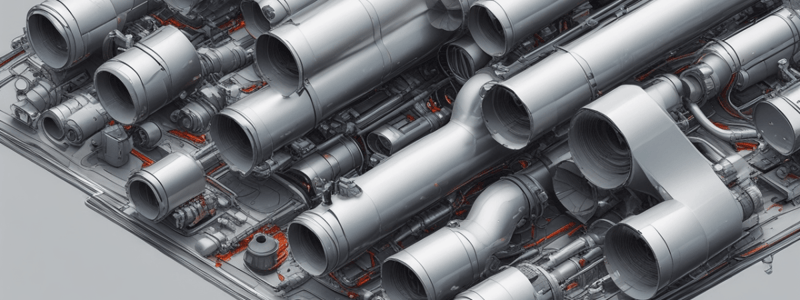Podcast
Questions and Answers
In the context of pipelining, what does RISC V stand for?
In the context of pipelining, what does RISC V stand for?
- Random Instruction Set Computer Version (correct)
- Real-time Information System Controller Vortex
- Rapid Instructional System Control Volume
- Reduced Instruction Set Computing Viscosity
What is the maximum number of clock cycles required to implement any RISC-V instruction?
What is the maximum number of clock cycles required to implement any RISC-V instruction?
- 6 clock cycles
- 3 clock cycles
- 4 clock cycles
- 5 clock cycles (correct)
During the Instruction Fetch (IF) cycle, what operation is performed on the Program Counter (PC)?
During the Instruction Fetch (IF) cycle, what operation is performed on the Program Counter (PC)?
- PC is incremented by 4 (correct)
- PC is incremented by 8
- PC is decremented by 4
- PC remains unchanged
Which of the following is NOT a valid clock cycle in the implementation described?
Which of the following is NOT a valid clock cycle in the implementation described?
In the Instruction Decode/Register Fetch (ID) cycle, what operation is performed on the immediate field of the instruction?
In the Instruction Decode/Register Fetch (ID) cycle, what operation is performed on the immediate field of the instruction?
What is the purpose of the temporary registers A and B in the implementation described?
What is the purpose of the temporary registers A and B in the implementation described?
Which of the following operations is NOT performed during the Instruction Decode/Register Fetch (ID) cycle?
Which of the following operations is NOT performed during the Instruction Decode/Register Fetch (ID) cycle?
Which of the following statements accurately describes the execution/effective address cycle (EX) for a memory reference instruction?
Which of the following statements accurately describes the execution/effective address cycle (EX) for a memory reference instruction?
In the execution/effective address cycle (EX) for a register-register ALU instruction, what operation does the ALU perform?
In the execution/effective address cycle (EX) for a register-register ALU instruction, what operation does the ALU perform?
How is the effective address calculated for a branch instruction during the execution/effective address cycle (EX)?
How is the effective address calculated for a branch instruction during the execution/effective address cycle (EX)?
During which cycle is the sign-extended immediate calculated for all RISC-V instructions?
During which cycle is the sign-extended immediate calculated for all RISC-V instructions?
Why is a separate sign-extension needed for store instructions, according to the given information?
Why is a separate sign-extension needed for store instructions, according to the given information?
In the execution/effective address cycle (EX) for a register-immediate ALU instruction, what operation does the ALU perform?
In the execution/effective address cycle (EX) for a register-immediate ALU instruction, what operation does the ALU perform?
Describe the key steps involved in the Instruction Fetch (IF) cycle of the RISC-V implementation.
Describe the key steps involved in the Instruction Fetch (IF) cycle of the RISC-V implementation.
Explain the purpose of the temporary registers A and B in the Instruction Decode/Register Fetch (ID) cycle.
Explain the purpose of the temporary registers A and B in the Instruction Decode/Register Fetch (ID) cycle.
Describe the operation performed by the ALU during the execution/effective address cycle (EX) for a register-immediate ALU instruction.
Describe the operation performed by the ALU during the execution/effective address cycle (EX) for a register-immediate ALU instruction.
How does the implementation handle the more aggressive version of the branch instruction, as mentioned at the end of the section?
How does the implementation handle the more aggressive version of the branch instruction, as mentioned at the end of the section?
Explain why a separate sign-extension is needed for store instructions, according to the given information.
Explain why a separate sign-extension is needed for store instructions, according to the given information.
What is the maximum number of clock cycles required to implement any RISC-V instruction, according to the information provided?
What is the maximum number of clock cycles required to implement any RISC-V instruction, according to the information provided?
Explain the key difference in how the sign-extended immediate is calculated for store instructions compared to other instructions.
Explain the key difference in how the sign-extended immediate is calculated for store instructions compared to other instructions.
What is the purpose of the temporary register ALUOutput in the described implementation?
What is the purpose of the temporary register ALUOutput in the described implementation?
Describe the operation performed by the ALU during the Execution/Effective Address cycle (EX) for a branch instruction.
Describe the operation performed by the ALU during the Execution/Effective Address cycle (EX) for a branch instruction.
Explain the significance of calculating the sign-extended immediate during the Instruction Decode/Register Fetch (ID) cycle for all RISC-V instructions.
Explain the significance of calculating the sign-extended immediate during the Instruction Decode/Register Fetch (ID) cycle for all RISC-V instructions.
How does the ALU operation differ between register-register ALU instructions and register-immediate ALU instructions during the Execution/Effective Address cycle (EX)?
How does the ALU operation differ between register-register ALU instructions and register-immediate ALU instructions during the Execution/Effective Address cycle (EX)?
Explain the purpose of the Execution/Effective Address cycle (EX) in the context of memory reference instructions.
Explain the purpose of the Execution/Effective Address cycle (EX) in the context of memory reference instructions.
Explain the purpose and significance of the prediction buffer shown in Figure C.17, and how it relates to pipelining performance.
Explain the purpose and significance of the prediction buffer shown in Figure C.17, and how it relates to pipelining performance.
Describe the key differences between the unpipelined and pipelined implementations of RISC-V discussed in the text, and the potential performance benefits of pipelining.
Describe the key differences between the unpipelined and pipelined implementations of RISC-V discussed in the text, and the potential performance benefits of pipelining.
Explain the role and purpose of the sign-extension operation mentioned in the text, and why it is necessary for certain instructions in the RISC-V architecture.
Explain the role and purpose of the sign-extension operation mentioned in the text, and why it is necessary for certain instructions in the RISC-V architecture.
Describe the role and purpose of the temporary registers A and B mentioned in the implementation described in the text, and how they are used in the execution of different instruction types.
Describe the role and purpose of the temporary registers A and B mentioned in the implementation described in the text, and how they are used in the execution of different instruction types.
Explain the potential performance impact of incorporating floating-point operations into the pipelined implementation described in the text, and any additional considerations or challenges that may arise.
Explain the potential performance impact of incorporating floating-point operations into the pipelined implementation described in the text, and any additional considerations or challenges that may arise.
Based on the information provided, explain how the pipelined implementation of RISC-V would handle control transfer instructions like branches and jumps, and the potential performance impact of such instructions on the pipeline.
Based on the information provided, explain how the pipelined implementation of RISC-V would handle control transfer instructions like branches and jumps, and the potential performance impact of such instructions on the pipeline.
Flashcards are hidden until you start studying




